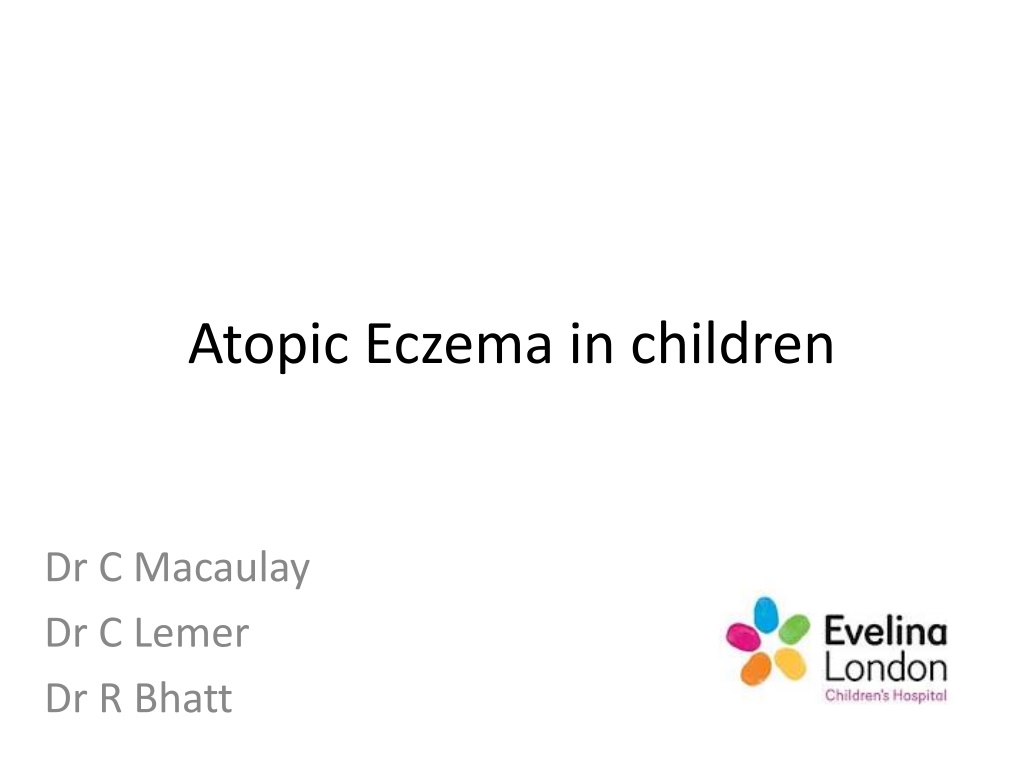Understanding Atopic Eczema in Children and Its Management
Atopic eczema is a chronic inflammatory skin condition in children with varying severity. Proper management is crucial to reduce its impact on a child's life. Identifying triggers, assessing severity, and implementing a stepped treatment approach are key in managing this condition effectively.
Download Presentation

Please find below an Image/Link to download the presentation.
The content on the website is provided AS IS for your information and personal use only. It may not be sold, licensed, or shared on other websites without obtaining consent from the author. Download presentation by click this link. If you encounter any issues during the download, it is possible that the publisher has removed the file from their server.
E N D
Presentation Transcript
Atopic Eczema in children Dr C Macaulay Dr C Lemer Dr R Bhatt
Background Chronic inflammatory itchy skin condition Episodic (have flares) Can affect any age Will resolve in some children but others may develop other atopic conditions i.e. the Atopic march
Why is it important? Affects many children in different severities Can have significant impact on a child or young person and their family Success of management relies on the relationship with healthcare professional and the child Education is key for management Can have coexisting allergies
Management Is hard! Important to assess the severity and impact on life Distribution can vary depending on age
Assessing severity The severity of the atopic eczema is grouped into 4 categories: Clear suggests that the skin is normal with no evidence of active atopic eczema. Mild indicates areas of dry skin and infrequent itching, with or without small areas of redness. Moderate severity is areas of dry skin, frequent itching, redness with or without excoriation and localised skin thickening. Severe atopic eczema has widespread areas of dry skin, incessant itching and redness with or without excoriation, extensive skin thickening, bleeding, oozing, cracking and alteration of pigmentation. There are also 4 categories for the impact on quality of life and psychosocial wellbeing: None, as it suggests, has no impact on the child s quality of life. Mild means there is little impact on everyday activities Moderate is defined as moderate impact on everyday activities and psychosocial wellbeing, with frequently disturbed sleep Severe indicates that there is severe limitation of everyday activities and psychosocial functioning, with loss of sleep every night
Are there any triggers? Identify potential trigger factors including: irritants skin infections contact allergens food allergens inhalant allergens.
Treatment A Stepped approach Emollients are the mainstay of treatment Treatment should be tailored to severity Can be stepped up or down depending on response Families should be educated in spotting flares and how to step up or down therapy
Treatment - Emollients Should be used multiple times a day Should be continued even when the skin is clear Should be using 250-500g/week
Treatment Steroid creams For the face and neck use mild potency steroids except for short- term (3 5 days) use of moderate potency for severe flares For flares in vulnerable sites- use mild potency steroids except for short- term (7 14 days) use of such as axilla and groin moderate or potent preparations for short periods only
Severe Topical Steroids Moderate Mild Increasing potency
DO NOT USE. Potent topical corticosteroids on the face and neck Potent topical corticosteroids in children under 1 year unless advised by a specialist Very potent steroids e.g Dermovate without specialist dermatological advice
Secondary infections Consider secondary infection: Particularly if not improving, rapidly worsening or if there is weeping, crusting, fever or malaise Treat with tropical or oral antibiotics If frequent infections consider antimicrobial emollient E.g. Dermol 500 Beware eczema herpeticum - Requires immediate referral to paediatrics. Important to alert parents on how to recognise infection
Top tips Do not use aqueous cream as an emollient Encourage daily bathing with bath oils & soap substitute unless otherwise specified Don t be afraid to start topical steroids Step up and step down steroid strengths use weakest that you can to gain control then reduce Ointments are oil based and more hydrating 1 fingertip (little finger) unit of steroids should be used for an area of two palms
Take Home Messages Common presentation and largely managed in primary care Can have significant impact on life and self esteem Its all about emollients Important to educate the family Using emollient Stepping up/down therapy Recognising secondary infection
Resources http://www.nhs.uk/conditions/pregnancy- and-baby/pages/eczema-in-children. https://nationaleczema.org/eczema/child- eczema/ https://www.allergyuk.org/atopic-dermatitis- and-eczema-in-children/atopic-dermatitis- eczema-in-children

























